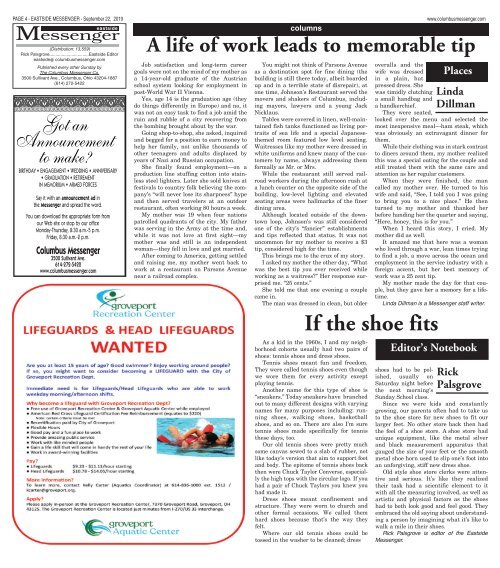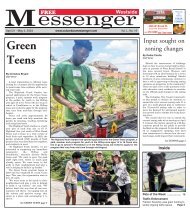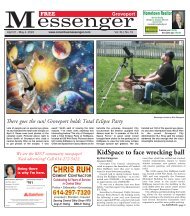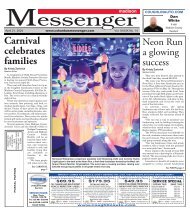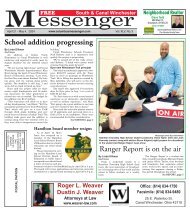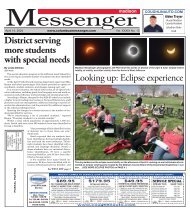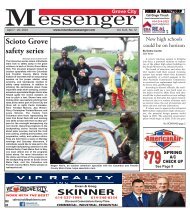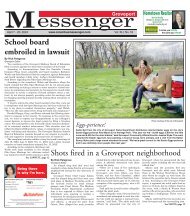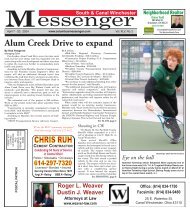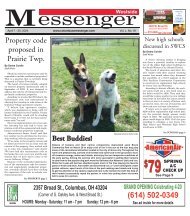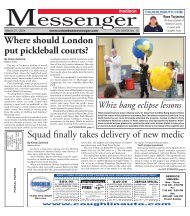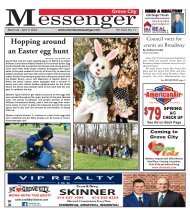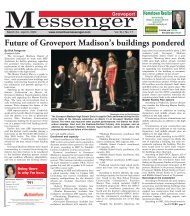Eastside Messenger - September 22nd, 2019
You also want an ePaper? Increase the reach of your titles
YUMPU automatically turns print PDFs into web optimized ePapers that Google loves.
PAGE 4 - EASTSIDE MESSENGER - <strong>September</strong> 22, <strong>2019</strong><br />
eastside<br />
<strong>Messenger</strong><br />
(Distribution: 13,559)<br />
Rick Palsgrove................................<strong>Eastside</strong> Editor<br />
eastside@ columbusmessenger.com<br />
Published every other Sunday by<br />
The Columbus <strong>Messenger</strong> Co.<br />
3500 Sullivant Ave., Columbus, Ohio 43204-1887<br />
(614) 272-5422<br />
BIRTHDAY • ENGAGEMENT • WEDDING • ANNIVERSARY<br />
• GRADUATION • RETIREMENT<br />
IN MEMORIUM • ARMED FORCES<br />
Say it with an announcement ad in<br />
the <strong>Messenger</strong> and spread the word.<br />
You can download the appropriate form from<br />
our Web site or stop by our office<br />
Monday-Thursday, 8:30 a.m.-5 p.m.<br />
Friday, 8:30 a.m.-2 p.m.<br />
Columbus <strong>Messenger</strong><br />
3500 Sullivant Ave.<br />
614-272-5422<br />
www.columbusmessenger.com<br />
www.columbusmessenger.com<br />
columns<br />
A life of work leads to memorable tip<br />
Job satisfaction and long-term career<br />
goals were not on the mind of my mother as<br />
a 14-year-old graduate of the Austrian<br />
school system looking for employment in<br />
post-World War II Vienna.<br />
Yes, age 14 is the graduation age (they<br />
do things differently in Europe) and no, it<br />
was not an easy task to find a job amid the<br />
ruin and rubble of a city recovering from<br />
the bombing brought about by the war.<br />
Going shop-to-shop, she asked, inquired<br />
and begged for a position to earn money to<br />
help her family, not unlike thousands of<br />
other teenagers and adults displaced by<br />
years of Nazi and Russian occupation.<br />
She finally found employment–on a<br />
production line stuffing cotton into stainless<br />
steel lighters. Later she sold knives at<br />
festivals to country folk believing the company’s<br />
“will never lose its sharpness” hype<br />
and then served travelers at an outdoor<br />
restaurant, often working 80 hours a week.<br />
My mother was 19 when four nations<br />
patrolled quadrants of the city. My father<br />
was serving in the Army at the time and,<br />
while it was not love at first sight–my<br />
mother was and still is an independent<br />
woman–they fell in love and got married.<br />
After coming to America, getting settled<br />
and raising me, my mother went back to<br />
work at a restaurant on Parsons Avenue<br />
near a railroad complex.<br />
You might not think of Parsons Avenue<br />
as a destination spot for fine dining (the<br />
building is still there today, albeit boarded<br />
up and in a terrible state of disrepair), at<br />
one time, Johnson’s Restaurant served the<br />
movers and shakers of Columbus, including<br />
mayors, lawyers and a young Jack<br />
Nicklaus.<br />
Tables were covered in linen, well-maintained<br />
fish tanks functioned as living portraits<br />
of sea life and a special Japanesethemed<br />
room featured low level seating.<br />
Waitresses like my mother were dressed in<br />
white uniforms and knew many of the customers<br />
by name, always addressing them<br />
formally as Mr. or Mrs.<br />
While the restaurant still served railroad<br />
workers during the afternoon rush at<br />
a lunch counter on the opposite side of the<br />
building, low-level lighting and elevated<br />
seating areas were hallmarks of the finer<br />
dining area.<br />
Although located outside of the downtown<br />
loop, Johnson’s was still considered<br />
one of the city’s “fancier” establishments<br />
and tips reflected that status. It was not<br />
uncommon for my mother to receive a $3<br />
tip, considered high for the time.<br />
This brings me to the crux of my story.<br />
I asked my mother the other day, “What<br />
was the best tip you ever received while<br />
working as a waitress?” Her response surprised<br />
me. “25 cents.”<br />
She told me that one evening a couple<br />
came in.<br />
The man was dressed in clean, but older<br />
As a kid in the 1960s, I and my neighborhood<br />
cohorts usually had two pairs of<br />
shoes: tennis shoes and dress shoes.<br />
Tennis shoes meant fun and freedom.<br />
They were called tennis shoes even though<br />
we wore them for every activity except<br />
playing tennis.<br />
Another name for this type of shoe is<br />
“sneakers.” Today sneakers have branched<br />
out to many different designs with varying<br />
names for many purposes including: running<br />
shoes, walking shoes, basketball<br />
shoes, and so on. There are also I’m sure<br />
tennis shoes made specifically for tennis<br />
these days, too.<br />
Our old tennis shoes were pretty much<br />
some canvas sewed to a slab of rubber, not<br />
like today’s version that aim to support foot<br />
and body. The epitome of tennis shoes back<br />
then were Chuck Taylor Converse, especially<br />
the high tops with the circular logo. If you<br />
had a pair of Chuck Taylors you knew you<br />
had made it.<br />
Dress shoes meant confinement and<br />
structure. They were worn to church and<br />
other formal occasions. We called them<br />
hard shoes because that’s the way they<br />
felt.<br />
Where our old tennis shoes could be<br />
tossed in the washer to be cleaned; dress<br />
overalls and the<br />
wife was dressed<br />
in a plain, but<br />
pressed dress. She<br />
was timidly clutching<br />
a small handbag and<br />
a handkerchief.<br />
They were seated,<br />
looked over the menu and selected the<br />
most inexpensive meal–ham steak, which<br />
was obviously an extravagant dinner for<br />
them.<br />
While their clothing was in stark contrast<br />
to diners around them, my mother realized<br />
this was a special outing for the couple and<br />
still treated them with the same care and<br />
attention as her regular customers.<br />
When they were finished, the man<br />
called my mother over. He turned to his<br />
wife and said, “See, I told you I was going<br />
to bring you to a nice place.” He then<br />
turned to my mother and thanked her<br />
before handing her the quarter and saying,<br />
“Here, honey, this is for you.”<br />
When I heard this story, I cried. My<br />
mother did as well.<br />
It amazed me that here was a woman<br />
who lived through a war, lean times trying<br />
to find a job, a move across the ocean and<br />
employment in the service industry with a<br />
foreign accent, but her best memory of<br />
work was a 25 cent tip.<br />
My mother made the day for that couple,<br />
but they gave her a memory for a lifetime.<br />
Linda Dillman is a <strong>Messenger</strong> staff writer.<br />
If the shoe fits<br />
shoes had to be polished,<br />
usually on<br />
Saturday night before<br />
the next morning’s<br />
Sunday School class.<br />
Places<br />
Linda<br />
Dillman<br />
Editor’s Notebook<br />
Rick<br />
Palsgrove<br />
Since we were kids and constantly<br />
growing, our parents often had to take us<br />
to the shoe store for new shoes to fit our<br />
larger feet. No other store back then had<br />
the feel of a shoe store. A shoe store had<br />
unique equipment, like the metal silver<br />
and black measurement apparatus that<br />
gauged the size of your feet or the smooth<br />
metal shoe horn used to slip one’s foot into<br />
an unforgiving, stiff new dress shoe.<br />
Old style shoe store clerks were attentive<br />
and serious. It’s like they realized<br />
their task had a scientific element to it<br />
with all the measuring involved, as well as<br />
artistic and physical factors as the shoes<br />
had to both look good and feel good. They<br />
embraced the old saying about understanding<br />
a person by imagining what it’s like to<br />
walk a mile in their shoes.<br />
Rick Palsgrove is editor of the <strong>Eastside</strong><br />
<strong>Messenger</strong>.


